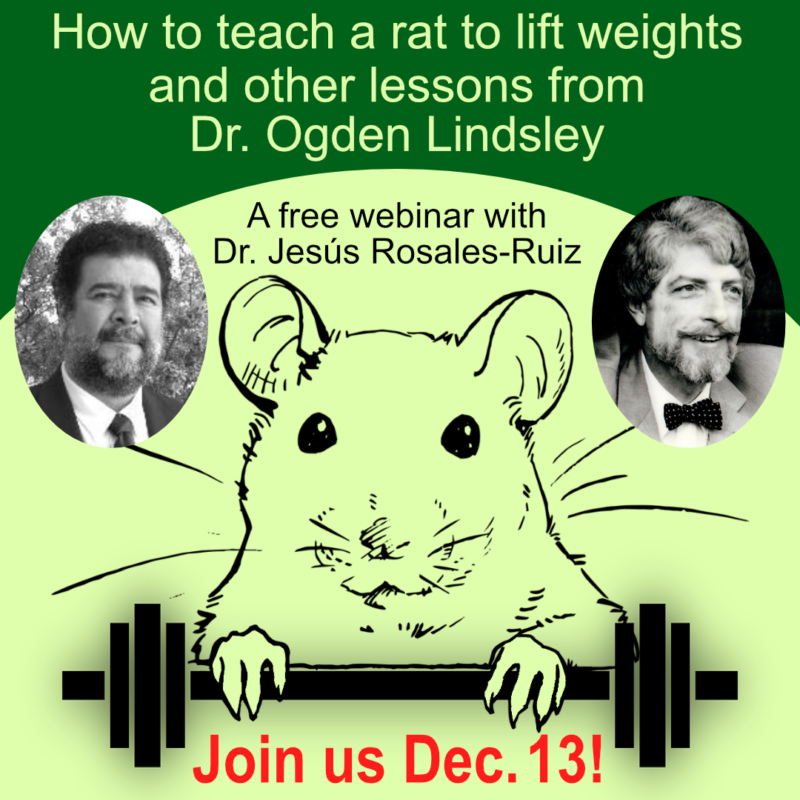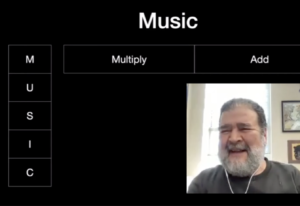In this webinar, Dr. Rosales-Ruiz shared some of his favorite stories from his time working with Dr. Ogden Lindsley. He discussed what it was like working with Ogden, how to think about research, Ogden’s ideas about movement cycles and conditioned reinforcers, the acronym MUSIC, and more. He even explained why you shouldn't milk a chicken!

Who was Dr. Ogden Lindsley?
Dr. Ogden Lindsley was a pioneering behavior scientist who helped bring reinforcement and shaping out of the laboratory and into applied settings. His research spanned a wide range of concepts, but he was particularly passionate about fluency-based instruction and improving classroom teaching.
In late December 2022, Sloan Publishing released a book about Dr. Ogden Lindsley. The book, which is titled A Tribute to Ogden R. Lindsley: His Life and Contributions, features thirteen chapters by some of Dr. Lindsley’s students and colleagues.
To celebrate the release of the book, Behavior Explorer invited Dr. Jesús Rosales-Ruiz to give a free webinar about Dr. Lindsley. Dr. Rosales-Ruiz studied with Ogden Lindsley while he was working on his Ph.D at the University of Kansas.
Webinar Recording
Webinar Excerpts
Behavior multiplies!
Visit our YouTube channel to watch a four-minute excerpt in which Dr. Jesús Rosales-Ruiz discusses the idea of how behavior multiplies. He explains why we shouldn’t dismiss small behavior changes and how behavior change should happen fast.
Webinar Resources
Suggested article: Our Aims, Discoveries, Failures, and Problem, by Ogden R. Lindsley (1990). Jesús discussed this article during the webinar. You can find a PDF of the article on the Celeration website.
Webinar Table of Contents
0:00:00 Introduction
Dr. Jesús Rosales-Ruiz begins the webinar by discussing why he wanted to meet Dr. Ogden Lindsley. He also talks about how he originally found out about Dr. Lindsley’s research while he was working on his undergraduate degree in Mexico. Eventually, Jesús met Ogden at his first ABAI convention and, shortly after, he began studying with and working with Ogden.
0:12:20 What did you learn during your meetings with Ogden?

When Jesús first started meeting with Ogden, they spent time reading and discussing B. F. Skinner’s classic 1938 text, The Behavior of Organisms. Ogden used this as an opportunity to relate the experimental analysis of behavior back to Precision Teaching and other applications of behavior analysis.
Jesús discusses the importance of looking at the details of your procedures and the chain of behaviors that the learner engages in. Many people don’t pay attention to these details, which is why a lot of research with humans has failed to replicate some of the results obtained from experiments with animals.
This section of the webinar contains an audio clip in which Dr. Ogden Lindsley discusses the strategies and tactics he used while conducting research.
0:27:30 Ogden’s honest feedback (and why you shouldn’t try to milk a chicken!)
Jesús talks about some of the feedback Ogden gave him related to several projects dealing with schedules of reinforcement. Jesús also discusses his master’s thesis, in which he was going to replicate a previous study and investigating how generalization works. He was very proud of his idea for the study. However, after sharing his idea with Ogden, he completely changed his project! While discussing this story, Jesús explains the importance of using the control strategy and approaching research inductively.
0:40:20 The importance of conditioned reinforcers during shaping

One reason why Jesús wanted to meet Ogden initially was because Ogden had a reputation as an excellent shaper. He had even shaped a rat named Sampson to press a lever that was twice Sampson’s weight. Jesús discusses the importance of conditioned reinforcers during shaping, how conditioned reinforcers work in two directions, and why Ogden preferred the term “response definer” instead of “conditioned reinforcer.”
This section of the webinar contains an audio clip in which Dr. Ogden Lindsley discusses the importance of conditioned reinforcers (response definers) during shaping.
0:50:20 Movement Cycles and the dead man’s (dead person’s) test
One idea Jesús learned from Ogden was the concept of the “movement cycle.” If you understand movement cycles, you will have an easier time measuring behavior and finding approximations during shaping. Movement cycles will also help you revive dead people because they will help you see a larger picture of the behavior.
During this section, Jesús shared an audio clip in which Ogden discusses movement cycles and a second audio clip in which Ogden discusses the dead man’s test.

1:09:00 The acronym MUSIC
Ogden used the acronym MUSIC to highlight several important ideas that precision teachers had discovered. For example, the “M” in MUSIC stands for Multiply because Ogden believed that behavior should live and grow in a multiple world. During this last section of the webinar, Jesús discusses each of the letters in MUSIC and the implications that they have for our own teaching and research.
About the book
A Tribute to Ogden R. Lindsley: His Life and Contributions
Edited by: Abigail B. Calkin
This book was released in December 2022 from Sloan Publishing.
The book includes 13 chapters by Ogden Lindsley’s students, colleagues, longtime precision teachers, and Ogden’s wife. It is a charming portrait of Dr. Lindsley as a scientist, creator, and human.
Click here to view the book on the Sloan Publishing website.


Thank you for this great offer! I am so sad that I am not able to attend.
I wish you great sccess and a lot of fun
Will this be recorded so I can view later?
Hi Jan, Thank you for your interest in the webinar.
Yes, we are planning to record it and make the recording available. It’s our first time doing a webinar. So, as long as we don’t run into any technology issues, we should be able to post the recording on our website later this month.
I would suggest that you go ahead and fill out the registration form. When the recording is available, we’ll send an email to everyone who registered.
~Mary
Excellent information.
One part had a profound effect on me which surprised me coming out of the blue. When Jesus said, ‘hospitals in the 1950’s were scary places,’ in a flash I had a momentary tear in my eye and a knot in my stomach. I had my appendix out at 4 years old in 1954. I should have been in for 10 days but was sent home after 7 days as I was so unhappy. I remembered I wanted to go on the rocking horse on the other side of the ward but I wasn’t allowed. I went on to work with horses and I’m still scared of hospitals (but not veterinary hospitals).
Thanks for sharing this, Elaine. It’s so interesting how emotions can get attached to certain places and also to the memories of these places. Your story precisely illustrates why Ogden wanted to move his research to the classroom.